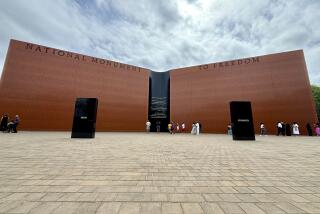Slave Experience Revisited in Words, Photos
- Share via
The narratives tell of 5 million slaves who worked in the fields from sunup to sundown. If they dared to slow the pace, they would get bullwhipped. They secretly met to pray and sing. They created a vital and dynamic culture based on their diverse African roots and molded by their common experience.
“The very earliest thing that I remember was the selling of my mother,” wrote Thomas Rutling, a former slave, in 1872. “I must have been about two years old. . . . I can just remember how the steps looked to our sitting room door, where I was when she kissed me and bade me goodbye, and how she cried when they led her away.”
Rutling’s moving words are just part of a traveling Smithsonian Institution exhibition of photographs and narratives recounting experiences of African American life prior to the Emancipation Proclamation of 1863. The show opens today at Ventura College.
“The exhibit displays this indomitable will to survive,” said Jesus Gonzales, the history instructor who brought the show to the campus after first seeing a smaller version of the photographs at the J. Paul Getty Museum five years ago. Gonzales learned that reproductions were available on large panels from the Smithsonian, contacted the institution and completed the application process. “Oftentimes, history portrays African Americans in the slave period as docile and accepting of their condition. When you see these photographs and narratives, you see that they weren’t docile and didn’t accept it. It’s a kind of historical revisionism.”
Portraits of men, women and children reveal their pain, as well as their determination. Other photographs show the baskets they weaved, the fields and cities they worked in and rows of dilapidated one-room houses, known as slave quarters.
“It’s trying to force us to look carefully at the photograph--to look at a sliver of reality, forcing you to scrutinize their life and their treatment,” Gonzales said.
It’s important to not forget about slavery, the Rev. Broderick A. Huggins said.
“It hangs on like a tiny thorn prick in the back of our brain,” he said. “We try to dismiss it . . . but we need to confront it and deal with the residue that still exists from the institution of slavery. The artifacts from the Smithsonian institute are a good reminder that it’s time to come to terms with how it has affected us and to not repress it in our memories.”
The opening ceremony and reception are at 3 p.m. at the library. The keynote speaker will be Huggins, and the St. Paul’s Baptist Church Oxnard Choir will be performing.
The exhibit runs through May 23 with a closing ceremony and reception at 3 p.m. Regular hours are 9 a.m. to 8 p.m. Monday to Thursday and 9 a.m. to 3 p.m. on Friday. The guest speaker at the closing ceremony will be the Rev. Kenneth Williams, and performing will be the New Hope Baptist Church Choir.
More to Read
The biggest entertainment stories
Get our big stories about Hollywood, film, television, music, arts, culture and more right in your inbox as soon as they publish.
You may occasionally receive promotional content from the Los Angeles Times.










